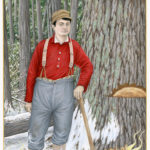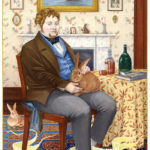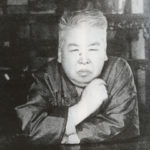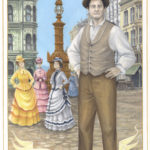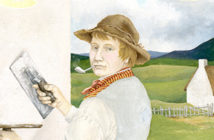LGBTQIA terms have always been complicated for me, primarily because their meaning and usage can change over time (both on a personal level and in the larger LGBTQIA community). And, some terms conflate gender and sexuality. Thankfully, new terms emerge at a rapid speed, so there is always the opportunity for a more tailored fit.
Of course, one could choose to not “label” themselves, but despite my complicated relationship with LGBTQIA terms, I’ve found them helpful in seeking out a community. Over the years I’ve used gay, dyke, transgender (trans), genderqueer, queer and now non-binary trans to refer to myself.
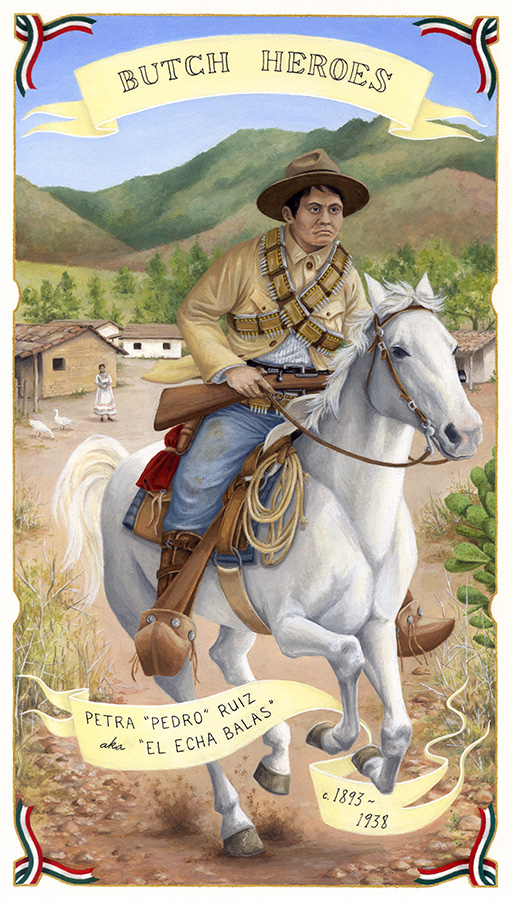
Ria Brodell, "Petra 'Pedro' Ruiz c. 1893-1938 Mexico," 2013, gouache on paper, 11 x 7 inches, In the collection of the Davis Museum at Wellesley College, Image courtesy of the artist.
Terminology is exciting in its evolution but also frustrating in its limitations. I choose not to attach contemporary LGBTQIA terms to the subjects of my Butch Heroes series, partly because none of these terms existed during their lifetimes, but primarily because I know the difficulty of finding terms that feel like they fit. I have no way of knowing how they would have self-identified given today’s options. Instead, I have to use their actions, their gender presentation and sometimes their own voice to determine the pronouns I use to refer to them, how I depict them, or whether they fit into the series at all.

Okuhara Seiko portrait, taken April 14,1912. Okuhara Family collection.
I know from their narratives that some of them identified as women, like Rosa Bonheur and Petra “Pedro” Ruiz. Some identified as men, like Sammy Williams or Captain Wright. Okuhara Seiko chose a name that gave no indication of gender. Others went back and forth, living sometimes as men and sometimes as women. Often they married women, or were caught using a “leather contrivance,” one of many euphemisms for a strap-on, or in the case of Sammy Williams, love letters from numerous women were found in his personal effects after he died.
I enjoyed finding this bit about Jean Bonnet:

Jeanne Bonnet, the French frog catcher, has been convicted for wearing man’s apparel, although she says she hasn’t other [sic]. Therefore if she didn’t wear it she would be convicted, too. How is Jeanne to keep out of prison?
Or from Cora Anderson, a.k.a. Ralph Kerwineo:
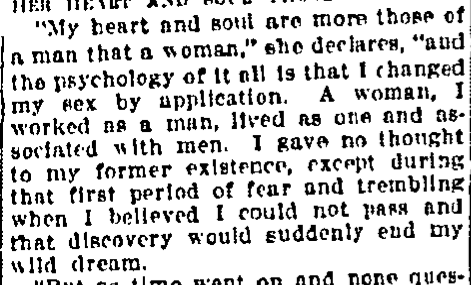
“Posed as a Man Ten Years and No One Ever Suspected That Cora Anderson Was a Girl,” Kansas City Star, 8 May 1914.
“My heart and soul are more those of a man that [sic]a woman,” she declares, “and the psychology of it all is that I changed my sex by application. A woman, I worked as a man, lived as one and associated with men. I gave no thought to my former existence, except during that first period of fear and trembling when I believed I could not pass and that discovery would suddenly end my wild dream.”
There is one term I chose to link all my subjects together: Butch. Butch has a history in the LGBTQIA community. Butch = Strength. And strength is one thing they all have in common.
- Ria Brodell, “Petra ‘Pedro’ Ruiz c. 1893-1938 Mexico,” 2013, gouache on paper, 11 x 7 inches, In the collection of the Davis Museum at Wellesley College, Image courtesy of the artist.
- Ria Brodell, “Billy or Sammy Williams c. 1828-1908 United States,” 2017, gouache on paper, 11 x 7 inches, In the collection of the Minnesota Museum of American Art, Image courtesy of the artist.
- Ria Brodell, “Captain Wright c. 1834 England,” 2016, gouache on paper, 11 x 7 inches, In the collection of the Davis Museum at Wellesley College, Image courtesy of the artist.
- Okuhara Seiko portrait, taken April 14,1912. Okuhara Family collection.
- Ria Brodell, “Jeanne or Jean Bonnet 1849-1876 United States,” 2012, gouache on paper, 11 x 7 inches, In the collection of the Henry Art Gallery, University of Washington, Image courtesy of the artist.
- Ria Brodell, “Cora Anderson aka Ralph Kerwineo 1876-1932 United States,” 2017, gouache on paper, 11 x 7 inches, Image courtesy of the artist.



